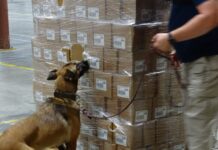

Shippers are now getting an even stronger voice in the air cargo supply chain and are more active than before in discussions, but they still seek more collaboration.
The International Air Cargo Association’s (TIACA) Shippers’ Advisory Committee (SAC) has given shippers a platform to air their concerns and views on the industry and brought shippers closer to the key debates.
Supporters of SAC include Ericsson, Bioforce, Chanel Perfums Beauté, Marine Harvest, Sandvik Machining Solutions, Teva Pharmaceutical Industries and Tosoh Corporation, together with the Global Shippers Forum (GSF) and European Shippers’ Council.
The group was formed last year and is chaired by Tosoh head of supply chain and general affairs, Lars Droog (pictured below) who says it has been a privilege to have in-depth debates with other members of SAC and all stakeholders, while he is convinced there are plenty of opportunities for the global airfreight industry.
A recent white paper ‘Change is needed’ was published in February by SAC and found shippers want all sectors of the supply chain to engage in constructive discussion and embrace new process and new technology.
The paper says change is needed to benefit the industry, and all sectors of the air cargo supply chain must work together to drive adoption of new technology and greater transparency.
Droog says shippers always felt like they had a voice, but having constructive discussions with all the other stakeholders in the industry is a huge positive change. “We’re not here to frustrate the industry; we are here to share our requirements and vision,” he notes.
Droog explains shippers feel efficiency and quality are the most important focus areas for air cargo. “A more efficient industry can be achieved by introducing new technologies such as the logistics data backbone and by focusing on lean processes skipping unnecessary physical/process steps in the air cargo chain).
“Certain commodities need special handling and the theoretical ‘verticals’ need to become reality. Pharma is a good example where airlines, ground handling companies, freight forwarders and trucking companies invest in the realisation of a full temperature controlled air cargo chain,” he explains.
His company, Tosoh Corporation works with all modes of transport so he says he has been able to bring to SAC a good understanding of the different modes and share best practices with the air cargo industry.
But what does Droog see as the biggest challenges?
“Global shippers more and more introduce an end-to-end supply chain approach. This means they would like to have full supply chain visibility and with airfreight this is still quite a challenge.
“Also the relatively high number of damages and missing pieces is something to improve. So I think visibility and quality are the most important challenges shippers are currently facing,” he says.
He believes the biggest opportunities for the air cargo industry are real collaboration between all the stakeholders and technological innovation such as the logistics data backbone.
Droog explains: “The logistics data backbone will enable organisations to share data. It means organisations don’t need to re-enter the same data over and over. It increases efficiency and at the same time it reduces the risk on mistakes. It could also decrease overall lead-times as pre-arrival customs clearances can be done when reliable information is available for all the stakeholders in the air cargo chain.
“Besides the technological innovation, there are plenty of other opportunities for the industry. It requires courage, faith and vision from the different stakeholders, but eventually it will increase the airfreight industry’s quality and thus competiveness. This will automatically lead to higher volumes.”
He notes the traditional airfreight model is very fragmented and this has a negative effect on efficiency, quality and transparency.
Droog says most airlines focus on the transportation of shipments from airport to airport and the logistic service providers take care of the transportation to/from the airport, while it is often urgent shipments are transported between warehouses (first line to second line warehouse facilities).
“It is really important to identify and drop redundant processes in order to decrease lead-times, decrease costs and risk of damage, and/or missing pieces,” he says.
But he is very upbeat about the future of air cargo as says when all stakeholders are open for the required change, innovation and collaboration, he is convinced there is a “beautiful future” for the industry.
TIACA’s new talent programme the Air Cargo Supply chain Internship (TACSCI) is one way it is looking build a bright future.
The initiative sees different stakeholders in the industry spend a full week visiting each other’s companies and discussing the business challenges. The first TACSCI took place last month in the Netherlands and was hailed a succees.
Droog says: “It is inspiring to witness how the ‘next generation’ is used to work together and to share information. It seems collaboration and transparency is in their DNA and I am therefore confident that this new generation will realise the changes needed to improve the competitiveness of the airfreight industry.”
The SAC fully supports the programme and is closely working with TIACA’s Education & Research Committee.
Droog concludes: “Whatever the future will eventually look like, it is clear that more collaboration between the parties is needed. Stakeholders must take on their responsibility to contribute to an optimised and innovative air cargo chain.
“Aviate, Innovate, Collaborate.”














